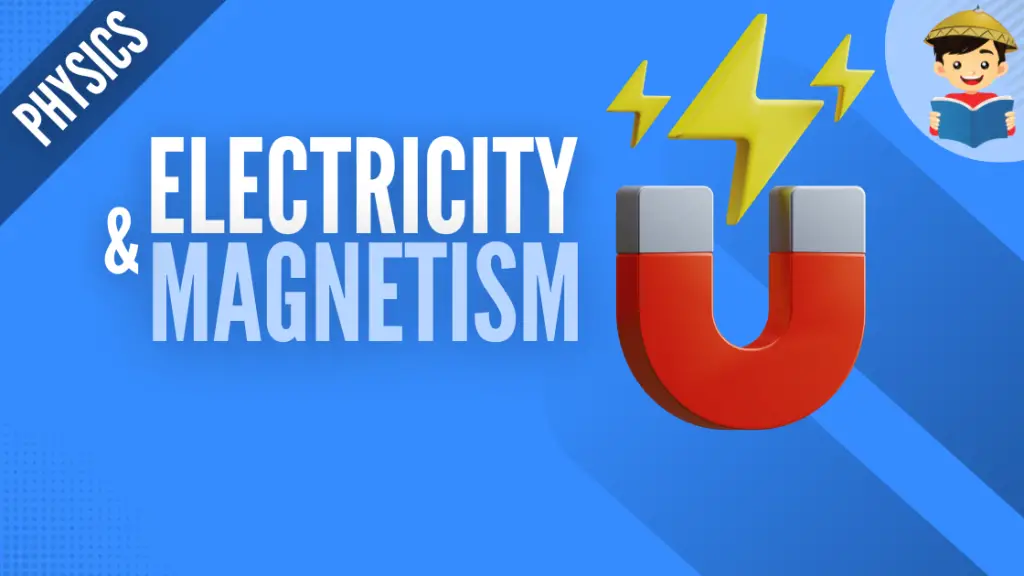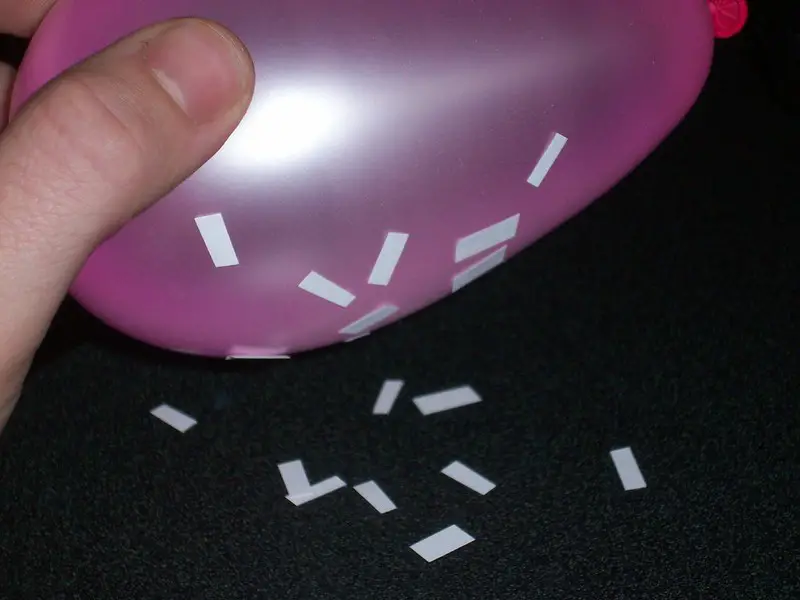Electricity and Magnetism

Electricity is no longer a luxury but a necessity we can’t survive without. However, some of us are unaware of what electricity is and what it is made of. In this reviewer, I’ll help you learn more about electricity and give you a glimpse of magnetism.
Click below to go to the main reviewers:
Table of Contents
- Part I. Electricity
- Part II. Circuits
- Part III. Magnetism
- Download Article in PDF Format
- Test Yourself!
Part I. Electricity
Have you ever wondered why your hair gets attracted to a comb when you comb your hair continuously? That is because of the electric charge! In studying electricity, it is important to understand the charges first.
A. Electric Charge
When we studied chemistry, we were first introduced to the concept of atoms. An atom makes up everything in this world, and each atom consists of a proton, electron, and neutron. In studying electricity, we will concentrate on protons and electrons because they possess an electric charge.
An electric charge can be generated when electrons are transferred to materials. Each electron carries a fundamental charge of 1.6×10-19 C. The magnitude of this is negative for electrons and positive for protons. All substances have a charge of multiple of this value, hence, electric charge is quantized.
In our example, the combing of hair results in gaining electric charges in the comb. When you comb your hair continuously, the comb becomes negatively charged because the electrons from your hair are transferred to the comb, leaving your hair positively charged. When two charges are unlike or not the same, they will attract or pull toward each other. That is the reason why your hair seems to move towards the comb.

On the other hand, when they are the same, they will repel or push away each other. This can be demonstrated when your hair tries to move away from each other by standing up and away from all the other strands. This example perfectly demonstrates static electricity. Rubbing materials like comb and hair, or even balloons and hair, can transfer electric charge.
Materials can be distinguished based on their ability to transfer electric charge. When materials can easily transfer electric charge and electrical current like metal, these are called conductors. On the other hand, materials that do not transfer electric charge like rubber, plastics, and wood are called insulators. Insulators are usually used to protect us from the dangers of electricity since they conduct electricity poorly.
B. Coulomb’s Law
The hair-comb example has shown that like charges repel, and opposite charges attract. This is due to the electric force between the two materials. It can easily be described in Coulomb’s law, which states that the magnitude of the electric force between two objects is directly proportional to the product of two charges and inversely proportional to the square of the distance between them.
Mathematically,

where k = 9×109 N ⋅ m2/C2. In case there are more than two charges, vector analysis must be done to determine the force upon the object.
Sample Problem
Find and describe the force between the two charges that are 4 meters apart if:
- q1 = +2.3×104 C; and
- q2 = -5.1×10-6 C.
Solution

A force of -6.6 N acts between the two charges. Since they have opposite charges, the force that acts between them is attractive.
C. Electric Field
The electric force forms an electric field that allows it to propagate. Any stationary object that has a charge creates an electric field around itself. If another charged object enters this electric field, interactions will occur.
The electric field strength generated by a point charge can be calculated using the formula

We use electric field lines to depict the electric field ideally. These lines point toward the negative charges and away from the positive charge. The more densely packed the field lines are, the greater the electric field strength.

D. Electric Potential, Current, and Resistance
In the previous reviewer, we have learned that objects have gravitational potential energy by virtue of their location, and work must be applied to move massive objects against the Earth’s gravitational field.
The same case can be applied to charged objects since these also have electric potential energy by virtue of their position in an electric field, and work must be exerted on the charged particles against the charged objects’ electric field.
We can also relate an object’s electric potential energy to its unit charge. Charged particles experience a change in electric potential energy as they move within an electric field. The more charged a particle is, the more electric potential energy it possesses. This concept is called electric potential, which is expressed as
ΔV = ΔPEelectric/q
This is measured in volts (V) equal to 1 J/C. Hence, we can say that a battery that contains 1.5 V has an energy of 1.5 J for every 1 C of charge.
When charges move, it is not only the electric potential energy that can be described but the flow itself. The flow of electric charge is known as the electric current, measured in amperes (A) equal to 1 coulomb of charge per second.
Current can be generated by positively charged and negatively charged particles, and its direction is always opposite to the movement of electrons.
The motion of charges can also be opposed, depending on the property of the material and its dimension. This ability is called resistance which is the ratio of electric potential to current. This is measured in ohms (Ω).
Part II. Circuits
Everything that needs electricity, from the light in your house to the gadgets that allow you to study this reviewer, is powered by a circuit.
A circuit is a series of electrical components such as batteries, bulbs, switches, resistors, and others connected in a complete loop.
To study a circuit, we must first understand its features, such as current, resistance, and voltage.
- Current (I) refers to the amount of charge flowing through a circuit per unit of time. It is measured in amperes (amps). The faster the current flows, the greater the amount of electrical energy transferred to the electrical components.
- Resistance (R) describes the amount of opposition to the current flowing in a circuit. It is measured in ohms (Ω). The higher the resistance, the lesser the current flow.
- Voltage (V) refers to the amount of potential energy between two points in a circuit, hence, it is also known as the potential difference. It is measured in volts (V).

These three features are related to one another. This relationship is summarized in Ohm’s Law, which states that the current is directly proportional to the voltage across the circuit and inversely proportional to the resistance.
Mathematically,
I = V/R
Types of Circuits
Electrical components can be connected along a circuit in two ways – in series and in parallel.
Series circuits connect devices in a single pathway for electron movement while parallel circuits connect devices in branched pathways to allow electrons to flow in different directions.
The table below summarizes how voltage, current, and resistance are described in the circuits.
| Series | Parallel | |
| Voltage | VT = V1 + V2 + … + VN-1 + VN | VT = V1 = V2 = …= VN-1 = VN |
| Current | IT = I1 = I2 = … = IN-1 = IN | IT = I1 + I2 + … + IN-1+ IN |
| Resistance | RT = R1 + R2 + … + RN-1 + RN | RT = 1/(1/R1 + 1/R2 + … + 1/RN-1 + 1/RN) |
In a series circuit, we can see that the total current is just the same through any component since there is only a single pathway available for the current to flow. Meanwhile, the total voltage, as well as the total resistance, is just equal to the sum of its components.
On the other hand, parallel circuits seem to be more complicated. The total current is equal to the sum of individual currents since there are multiple branches for the current to flow. Unlike the total voltage in a series circuit, the total voltage in a parallel circuit is just the same through any component. The total resistance in a parallel circuit is equal to the reciprocal of the sum of the inverse of each resistance.
Part III. Magnetism
We have been familiar with magnets since we were young, but have you ever thought about how they work?
Thousands of years ago, magnets were first discovered in the form of magnetite – a naturally magnetic iron oxide mineral commonly found in various kinds of rocks. From that moment until the present day, magnets have been used for different purposes.
We know what magnets look like and how they can attract metals like iron. They usually look like this:

A magnet has two ends that we call poles. One end is called a north pole (north-seeking pole) since it points toward the Earth’s north pole, while the other is known as the south pole (south-seeking pole) because it points towards the Earth’s south pole. This is because Earth acts as a gigantic magnet due to the number of magnetic materials it contains.
When you place two magnets together, the north pole of the first magnet repels the north pole of the second magnet and attracts its south pole. Hence, like poles repel and opposite poles attract.
Magnets can also be cut, and when cut, they will form a new, smaller magnet with its own set of poles.
Magnetic field
Say you have a magnet and iron filings on a table. As you place the magnet near the iron fillings slowly, there will come a point when the iron filings stick to the magnet. That is because magnets create an invisible area of magnetism called a magnetic field.
A magnetic field is produced by all moving charged particles. Magnetic fields can be depicted using magnetic field lines, like the electric field. These field lines will occur as a closed loop that continues to the magnet.
Next topic: Heat and Thermodynamics
Previous topic: Waves and Optics
Return to the main article: The Ultimate Physics Reviewer
Download Article in PDF Format
Test Yourself!
1. Practice Questions [PDF Download]
2. Answer Key [PDF Download]
Written by Mary Joy Montenegro
Mary Joy Montenegro
Mary Joy Montenegro is a licensed professional teacher who obtained her Master’s Degree in Teaching Physics at De La Salle University under the Department of Science and Technology Scholarship. Aside from teaching, she also loves traveling and meeting other people.
Copyright Notice
All materials contained on this site are protected by the Republic of the Philippines copyright law and may not be reproduced, distributed, transmitted, displayed, published, or broadcast without the prior written permission of filipiknow.net or in the case of third party materials, the owner of that content. You may not alter or remove any trademark, copyright, or other notice from copies of the content. Be warned that we have already reported and helped terminate several websites and YouTube channels for blatantly stealing our content. If you wish to use filipiknow.net content for commercial purposes, such as for content syndication, etc., please contact us at legal(at)filipiknow(dot)net
